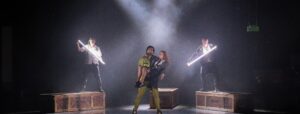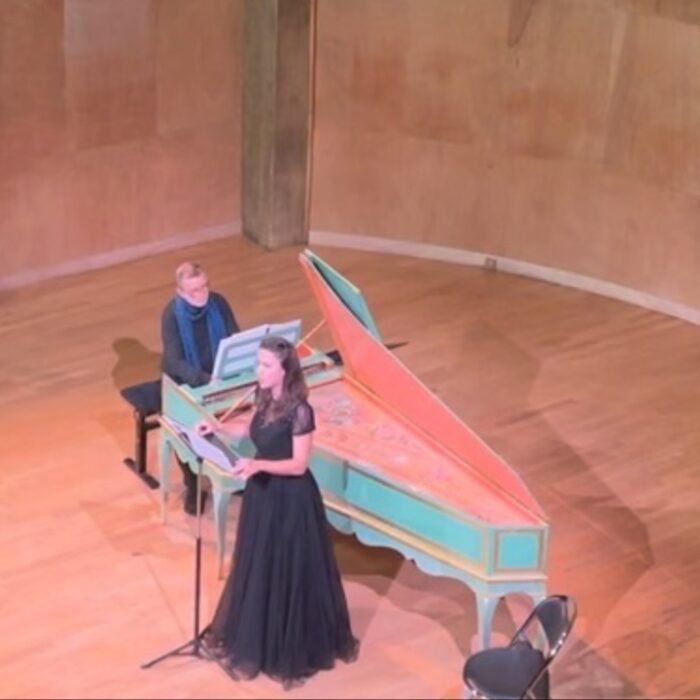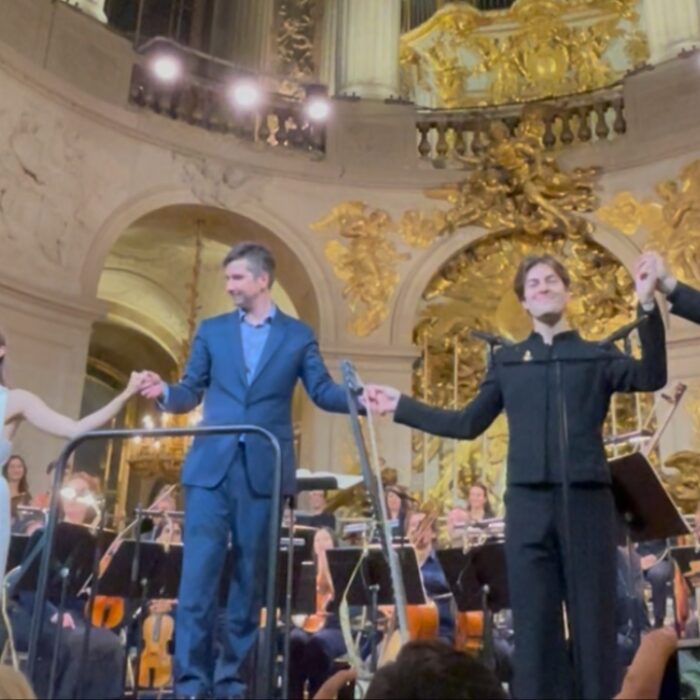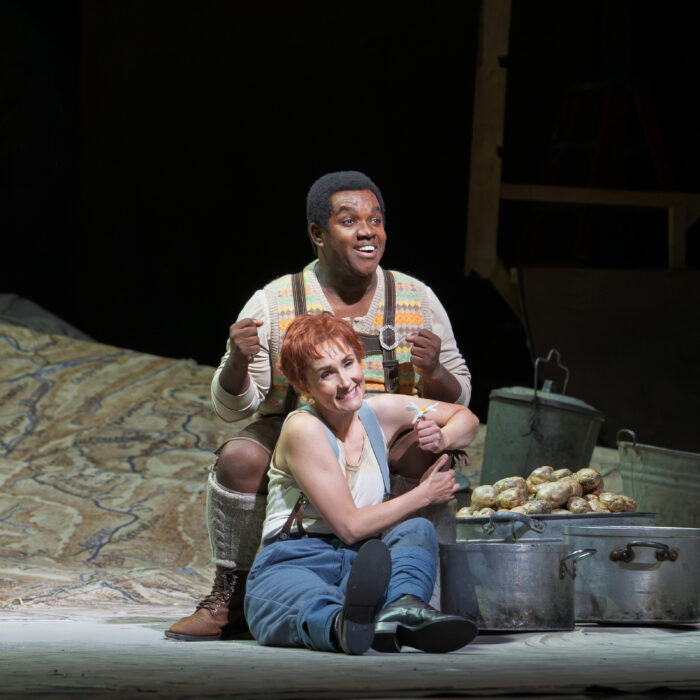
The Haydn Foundation, Bolzano 2023 Review: Peter Pan, The Dark Side
Mittere & Pountney’s warning about the dangers of social media
By Alan NeilsonCredit: Francesco Bondi
Each year, The Haydn Foundation of Bolzano and Trento presents a short program of operas with an emphasis on the new and experimental, which, this season, included the world premiere of “Peter Pan, The Dark Side,” written by the composer Wolfgang Mittere and librettist David Pountney. The idea for the work came from the foundation’s artistic director, Matthias Lošek, who, having a fascination with the “boy who never grows up,” decided to commission an opera on the subject but remodeled it for the 21st century. What emerged was a very dark, disturbing, yet realistic piece that made for uncomfortable viewing. This was no fairytale but a warning to parents and adolescents of the dangers that unrestricted access to social media can have on children, particularly those who are in vulnerable situations.
A Dark Character From Cyberspace
The opera opens with a scene that characterizes the life experienced by far too many children in modern societies. Wendy, Michael, and John are adolescent foster children who have been placed with a good-hearted but irresponsible foster mother, Tyger, who lives on the 38th floor of an apartment block. She clearly likes the children, but she also enjoys going out for the night with her friend Hook, so she leaves the children alone to entertain themselves, unconcerned about what they may get up to. The door is, thus, left open for the children, who, desperate to grow up, take the opportunity to explore the experiences on offer via the internet.
Wendy has been chatting with an interesting character online by the name of Peter Pan, who represents all her adolescent desires; he is exciting, adventurous, and attractive, and he wants her and her two foster brothers to meet him. So, with the confidence and impulsivity of teenagers, unrestrained by the care and oversight of responsible adults and unconcerned by the apparent dangers involved, they agree to join Peter and jump out of the window, and fall into Neverland.
Where they are exactly is not clear. Have they really jumped out of the window and are falling to their deaths? Have they been inveigled by Peter to leave the apartment and join him on the streets? Have they been sucked into the dark fantasy world of the internet, or is it a delirium caused by drug use? The answer is not important. Each, in its own way, can be related to the others and to the lives of not an insignificant few modern-day teenagers.
The director, Daisy Evans, took the line that the children, attracted by Peter’s promises and mesmerizing words, jumped from the window to their deaths. In the final scene, Tyger and Hook return from their night out at a fancy-dress party to find the coffins of the three dead children lying in wait. It is their fall from the 38th floor to the ground that constitutes the body of the opera; as they career downwards, they enter a different world, a modern dystopia of high-rise buildings, of drugs, of exploitation, violence, and crime, peopled by characters they know, such as Tyger and Hook, but also fabricated characters such as Tinkerbell, the Crocodile, The Lost Boys, and the Pirates, as well as by Peter Pan, who is a projection of Wendy’s desire.
Evans was aided in her presentation by the imaginative and effective set and costume designs of Loren Elstein. All the characters were dressed in modern clothes. In most cases, they were not in any way out of the ordinary: Hook wore jeans and a T-shirt; Wendy, a denim skirt and a white shirt and jacket; however, some characters were more colorfully and flamboyantly dressed, such as Tinkerbell in her silver, knee-length boots, and green plastic coat. The sets changed fairly regularly and often had a fragmented appearance that reflected the impermanence of the three children’s experiences as they plummeted downwards from one floor to the next. The staging was not aesthetically pleasing, nor was it meant to be; this was, after all, a nightmare experience. Video screens were often dotted about the stage, on which could be seen a body falling or the eye of the Crocodile watching over the events. Jake Wiltshire’s lighting added to the darkness with his dimly lit designs. There was little or nothing to protect the audience from what was an unsentimental portrayal of Wendy, Michael, and John’s predicament.
It was not so much the individual events per se that made the work such a dark and unsettling experience, but the strength of Pountney’s nuanced libretto and Evans’ directorial excellence that made them so realistic. Even within the context of this fantasy world, everything was wholly believable! Peter Pan’s relationship with The Lost Boys, for example, was not comradely but one predicated on fear; often, they huddled together as Peter rounded on them, his violence as sudden as it was vicious. Pountney’s text added to the work’s ambivalence; rarely are life’s events without grey areas, and there were plenty of such areas here. At one point, when Peter and Wendy are together, she shouts, “you touched me,” and, deeply upset, cries out, “I was touched before.” It could, of course, refer to sexual abuse, but not necessarily, as it could be referring to her own aversion to being touched, which is not uncommon in teenagers, or an allusion to physical violence she had previously suffered, or maybe it was something she learned from the internet. Again and again, relationships between the characters were never as one would normally expect; there was always something not quite right, something distorted, something unhealthy.
One negative criticism of Pountney’s text was his use of strong language, which was totally misplaced. Obviously, such language is used to create a sense of realism. The problem, however, is that once you go down that road, almost every sentence will require an expletive of some form, and normally ones far worse than those used. The effect of the occasional strong word simply draws attention to the fact there is so little bad language in the text, which is actually not realistic at all.
Wendy’s Death: A Warning For Society
Wendy’s journey into Neverland was a descent into an alternative dystopian reality from which she never returned. Yet it was in confronting the darkness that she realized her own humanity; it enabled her to grow, to mature, and to be of value to others. From an egoistic teenager, she developed into a more sensitive, caring individual who helped The Lost Boys escape Hook by bringing them into her home and was able to help Peter re-evaluate and develop a less egocentric attitude toward her. The fact that Wendy died before being able to develop this potential as she grew into adulthood turned the tale into a genuine tragedy. Instead, she becomes a victim of society’s neglect and failure to oversee and evaluate the effects of free access to the internet and social media and how it negatively impacts teenagers.
Mittere’s Intense, Disturbing Score
Timothy Redmond, conducting the Orchestra Haydn di Bolzano e Trento, brought Mittere’s score to life with an energetic and dramatically intense performance. To say it was an attractive, pleasing, or comfortable work to listen to, however, would not be correct. It was, in fact, disturbing and difficult. It was a piece of music that was constantly thrusting forward and rarely settled in order for the audience to relax. It was often harsh, disjointed, and angular, and mixed in electronic vibrations to ramp up the anxiety. Short musical quotations from other operas occasionally surfaced but did little to lighten the effect. In other words, it was fully in harmony with the onstage drama. There were one or two short sections in which the music calmed, such as in the scene in which Wendy and Peter became emotionally closer, which allowed the dramatic intensity to dissipate before being ramped up again while also providing the work with the necessary contrast and depth.
Mittere’s writing for the voices was equally uncomfortable to listen to, as he regularly forced the singers toward their upper limits in order to bring out their characters’ anxieties, fears, and emotional tensions.
Tenor Karim Sulayman as Peter Pan was superficially slick and engaging with a strong, pleasing stage presence. Costumed, of course, in a green suit, he certainly looked the part, and his clear-toned, attractive voice added to the initial impression of him as a decent young man, which his agile acting reinforced by emphasizing the impression of youth. It did not, however, take long for him to reveal his darker side: his egoistic and egocentric nature, his disposition towards angry outbursts, intimidation, and violence. He is also not a child. He has grown up. So why is he contacting children online?
Soprano Rosie Lomas produced a compelling performance as Wendy, in which her transition from a stereotypical teenager to someone with greater maturity was impressively presented. Her singing was wonderfully expressive, and she expertly captured her character’s changing emotions. Her voice combined well with Sulayman’s, which made their developing bond a fairly moving experience and an island of normality in a never-ending nightmare.
Tinkerbell was parted by soprano Claire Wild, who played her as an immature, petty, and jealous teenager. She possesses a firm, versatile voice with a pleasing tone, which she used convincingly to bring out her character’s, at times, nearly hysterical personality. The role’s high tessitura lay easily within her vocal ambit.
Soprano Gweneth Ann Rand was a larger-than-life Tyger who first appears in her apartment dressed as Wonder Woman on her way out to a fancy dress party. Her relationships with her foster children and Hook were convincingly developed; her interactions with them were always warm, natural, and totally believable. Her singing was bright, lively, and engaging.
Her two foster sons, John and Michael, were played, respectively, by baritone Dominic Kraemer and tenor Jakob Pejcic, both of whom engaged enthusiastically with their roles, acting out the parts with plenty of misdirected energy and ridiculous posturing typical of teenagers.
Bass-baritone Andreas Jankowitsch produced a well-sung and neatly acted performance in the role of Hook. He possesses a well-defined, versatile voice with plenty of character, which he uses intelligently to create a nuanced portrait of Peter’s sworn enemy. He was violent and unpredictable but, as with many men of this type, he also displayed a sentimental side to his character, especially in his relationship with Tyger, for whom he sang what was the closest a piece came to a recognized aria, which allowed him to show off the pleasing lyrical quality of his voice.
The countertenor, Andrew Watts, was parted as both the Babysitter and the Crocodile, which in Wendy’s imagination were probably two incarnations of the same person. Both were outsiders looking in; both had no sense of attachment to any other character and together, they seemed to be ever-present, oozing out their malevolence into the ether. Watts produced an extreme, piercing vocal sound that was suitably disturbing, in which his words were articulated clearly.
The chorus, Ensemble Vocale Continuum, under the guidance of Chorus Master Luigi Azzolini, was cast in the roles of The Lost Boys and The Pirates. Whereas The Lost Boys were young and frightened and clearly exploited by Peter Pan, The Pirates were older, and tougher but also represented more as comic book characters. All members were fully engaged with their parts and sang well.
Although lasting only 80 minutes, “Peter Pan, The Dark Side” is an emotionally draining piece. It demands a lot from the members of the audience, but it repays their concentration and emotional identification with a fine piece of theatre. Whether or not, however, Peter Pan was the right title or vehicle for a piece of this nature was less clear.



